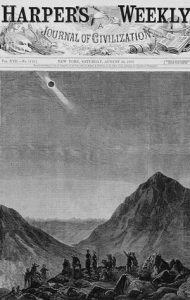The Total Eclipse of 1878
As we gear up for the Eclipse Across America this summer, it’s worth looking back at the history of eclipse viewing and the role it played in modern astronomy. Treks out to some remote location to view a solar eclipse were a type of pilgrimage for American astronomers, bringing together large numbers of scientists in one remote location. Questions were answered, rivalries were struck, scores were settled and a lot of good science was accomplished.
One of the most interesting was the solar eclipse of July 1878, which allowed several old friends (and enemies) to settle one of the most vexing questions of 19th century astronomy.
The path of the 1878 eclipse made it visible from Alaska down through the Rockies and then into the Gulf of Mexico and Cuba. There were a number of sites in its path that would be ideal for viewing: dry, elevated and dark. Even better: the decade old transcontinental railroad ran out to the path of the eclipse, meaning that astronomers could take along all the bulky equipment they could ship.
So the scientific community boxed up their gear and headed out to Rawlins, Wyoming, where the total eclipse would be visible for two minutes, fifty-six seconds. Along for the trip were men like Simon Newcomb of the Naval Observatory, soon to become possibly the most famous astronomer in America. Also in attendance was Norman Lockyer, founder of the journal Nature, and James Craig Watson of the Ann Arbor Observatory.
And also a 31 year old tinkerer named Thomas Edison, but that’s another story.


There was a great deal of scientific work to be done in the just-under three minutes of the eclipse, but the goal that caught the popular attention was the search for the hypothetical planet Vulcan.
The French mathematician Urbain Le Verrier had theorized the existence of this small planet in between Mercury and the Sun during the mid 19th century. Many astronomers considered it the most likely explanation for certain irregularities in the orbit of Mercury. But finding it had proved difficult. Many astronomers had caught fleeting glimpses of something in the right vicinity – asteroid, sunspot or maybe a small planet.
The search for Vulcan had taken on a new urgency after an eclipse in 1869, thanks to our own Benjamin Gould. After leaving Dudley, Gould had become one of the early astronomers skilled in photo-astronomy. He set up his equipment in Burlington, Iowa, during the eclipse in order to photograph the solar corona. On the right bank of the Mississippi he snapped forty two images of the eclipse.
Gould reasoned that if there was a planet orbiting between Mercury and the Sun, then it should be visible in the shadow of the eclipse. He examined his own photographs, plus over three hundred other photographs of the eclipse, and came to the conclusion that nothing was there. Not a man for mincing words, Gould announced, “I am convinced that this investigation dispenses with the hypothesis that the movement of the perihelion of Mercury results from the effects of one or many small interior planets.”
For Gould, the matter was settled. But popular theories don’t die that easily. For a while, most astronomers continued to find nothing. Then in April, 1876, a German astronomer working in northern China named Heinrich Weber sent a telegram back to Europe announcing that he had seen a circular object in transit across the Sun. Once again, the game was afoot.
America was still struggling to catch up to Europe in the realm of science. Many in the American scientific community would have loved to find Vulcan from a spot on American soil. So many of those tromping out to Wyoming were hoping to be the one to spot the rogue planet.
In the end, the verdict was mixed. Most of the astronomers, including Newcomb, had found nothing. Watson had, and Watson was a well respected observer. He also seemed to be supported by Lewis Swift, an amateur astronomer from Rochester who had been observing the eclipse in Denver.
Rochester has produced many fine astronomers, but in the end it came down to what Watson believed he saw. Surprisingly, Benjamin Gould’s verdict on Vulcan ended up being supported by his arch-nemesis – and fellow Dudley alumni – Christian F.H. Peters. After leaving Dudley, Peters had ended up at Hamilton College are racked up an impressive number of asteroid discoveries. He had been a Vulcan skeptic since the beginning, and he left no doubt that he believed Watson had made some basic errors in his supposed sighting.
While the journal Nature chided Peters for his tone, few seemed eager to defend Watson’s observations. After the bulk of the astronomers viewing the 1878 eclipse reported no luck in spotting Vulcan, the pendulum seems to shift towards skepticism. The problems with Mercury’s orbit remained, but the search for Vulcan drifted to a close. In 1915, Albert Einstein was able to use his new theories of gravitation to accurately predict the orbit of Mercury, ending any need for another planet and closing the debate.
